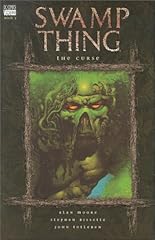
Swamp Thing Vol. 3 - The Curse
By Alan Moore, Stephen R. Bissette and John Totleben
It's a good thing Alan Moore and company do what they do well, because the heavy-handed politics on display in the first portion of this volume are the kind of thing that usually sours me on a story. But it was handled well. Obvious and in your face, yes, but well written and illustrated, and enhanced with newspaper clippings tossed around on the pages like so much litter, a presentation so strong that it's easy to forget that the politics are clunkier than the Moore of legend would give us.
At this point Moore started to use Swamp Thing as a platform to talk about Important Issues, from environmental issues to guns to racism and more. It's all a bit in your face, lacking the more refined approach he'd later develop, but he was probably able to develop that more subtle approach in part because he cut his teeth here. Besides, as far as I'm concerned it's hard to find fault with someone who is aspiring to do something great, and that is certainly what Moore was attempting. He was aiming high.
Like in "The Curse," for instance, a story centering on the societal abuse and subjugation of women. Moore takes the ancient tradition of "menstruation huts" and turns it into a tragic werewolf-on-the-loose story. A standard story with a shot of social commentary thrown in the mix. It's a good tale, but what really stands out is the way in which he uses repeated words, phrases and symbolism to underscore the thematic material he's dealing with. Moore would go on to use techniques like this in landmark works such as Watchmen.
The most notable thing in this volume, of course, is the introduction of John Constantine, star of the popular Hellblazer series, central character of a Keanu Reeves film, and the tie that binds so many of DC/Vertigo's magical/supernatural worlds together. It's interesting to see how fully formed he was from the start. This isn't an embryonic version of the character, it's him in all his surly, mysterious glory. He's great.
Also great is the way in which Alan Moore begins building a huge mystery, as if the end of the world is coming. Most of these stories are standalone tales or two-parters, yet this entire volume holds together as a unified whole because Moore injects this mounting dread into every story. They call it the "American Gothic" arc (which continues into Volume 4), and it's pretty great. The narrative jumps from place to place, dealing with the uglier aspects of Americana as he does. It's all over the map, but again, it stands together as a unified whole.
Reading this stuff makes me scratch my head at the people who dismiss Alan Moore as overrated. Here it becomes clear that he was dead brilliant even before he became Alan Moore Creator of Watchmen.
This is essential reading by any measure.
An earlier version of this review was originally posted at IMWAN.com.
Read my regular, everything-and-anything (usually on writing and music) blog right over here.





No comments:
Post a Comment